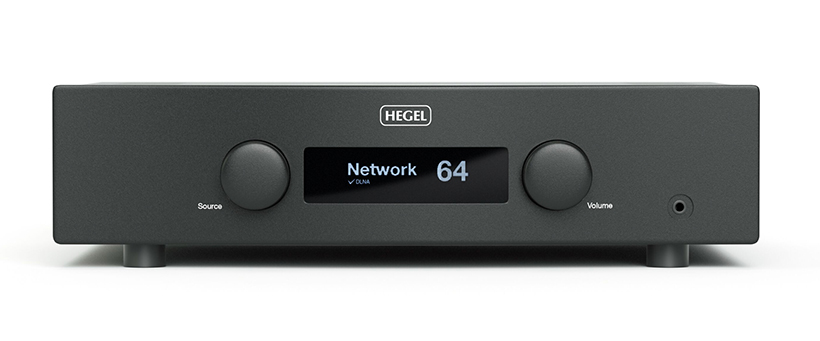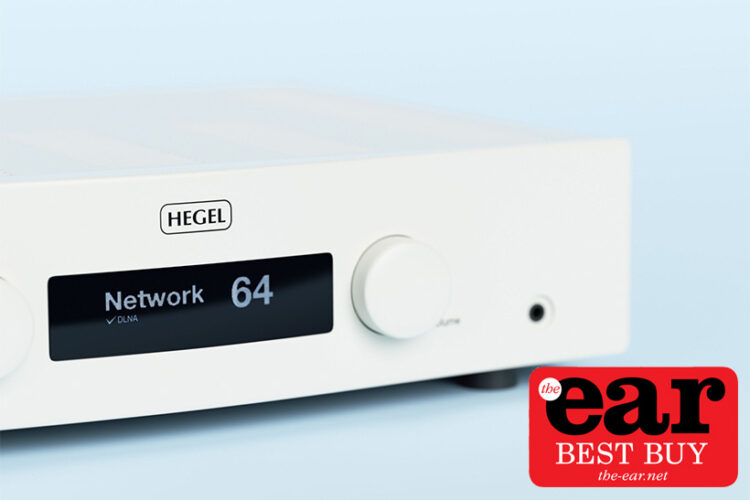To describe the Norwegian-conceived Hegel H190 as merely an integrated amplifier does it a disservice. Successor to the award-winning H160 it benefits from company founder Bent Holter’s refined SoundEngine2, first seen in the more powerful H360 model and boasting ten-times lower distortion than the first-generation. Added to this the unit’s onboard streaming ability (Tidal, Spotify, Airplay etc), a highly-competent DAC and we have all that’s needed to couple to a pair of speakers for a complete music system. With an output of 150 Watts per channel it is obviously capable of driving demanding loudspeakers of most stripes.
SoundEngine is Hegel’s own amplification system which has been created to combine the advantages of Class AB and Class A circuitry in one: the raison d’etrebeing to provide high power alongside a low signal-to-noise ratio by concentrating all engineering on the sound quality aspect of the design.

Externally, the design is sleek and the uncrowded fascia contains just two controls (input selection and volume) with a central display and a full fat headphone socket. The power switch is neatly located out of sight, below the left-hand dial.
Ins and Outs
We are offered a plethora of inputs and outputs to suit almost every conceivable need in this increasingly digital world. There is also an RJ45 Ethernet port for network connection (which I made full use of) to allow control over the internet, and wirelessly streaming from a mobile device using an AirPlay or DLNA source. (I relied heavily on the former for the majority of listening sessions involving recorded material.) Added to this, the H190 is the first model from this marque to benefit from Spotify Connect, allowing it to stream directly using an associated account.
With one coaxial and three optical digital inputs as well as USB connection, the back panel also houses a balanced analogue input as well as an unbalanced one via RCA phono. There are both fixed and variable unbalanced line-level outputs (I used these to drive some monoblocks although they would also accommodate connection to a subwoofer) as well as manly speaker terminals accepting spades, banana plugs or bare wire.

The digital inputs are compatible with PCM signals up to 24-bit/192kHz with the USB input suitable for up to 24-bit/96kHz to preserve plug-and-play compatibility without the need for additional Windows driver. Incoming analogue signals are converted to digital and upsampled to 24/192.
Technology
Using a negative feedback technology, the signal is monitored in real time; should unexpected distortion be detected it is elegantly phased out. Audibly it would appear to work since the H190 is just as quiet as it is powerful. I have been benefiting from this technology in the Röst which has beenin regular use since my 2017 review, it has formidable bass control as well as incredibly low noise floor and impressively clean output yet its specified output is half of the H190.
Much of the circuitry from the Röst has found its way into the H190, but it is a great deal more than a newer, bigger version of that design. I am delighted to see the OLED front-panel display retained, along with the choice of black or matt white finish options. “What we have here is not merely a Röst on steroids”, explains Bent. For a start there is a considerably upgraded DAC.

Like its big brother, the H190 has a damping factor of over 4,000 which is considerably higher than many amplifiers which have under 200. Over-damping certainly benefits bass response if this Hegel design is anything to go by.
Ease of use is improved by the amp’s Airplay compatibility, allowing it to play audio files stored in an Apple device via a home network. Airplay is lossless although limited to 16-bit/44.1kHz, but that’s more than enough for most of us (speak for yourself – Ed.). As a result I didn’t get much use out of Hegel’s responsive and deliciously tactile remote but this will be useful for many.The H190’s second streaming protocol is UPnP/DLNA which requires use of a third-party app and was outside the scope of this review.
Inside, the electronics are assembled on two circuit boards, one for analogue and the other devoted to digital circuitry and dubbed Sound Card by Hegel. This was built in-house using a Libre Wireless DSP module and includes Hegel’s own implementation of Airplay and a proprietary USB interface.
Sound quality
One has an immediate sensation with anything new, and that first impression opinion is a valid one. With the H190 I was aware of a sense of neutrality on recordings I knew well (including some which I had actually made) and a depth to the soundstage which surpassed that from equipment costing many-times more. Extending not just behind the speakers but well beyond the wall behind them. Across a wide range of material, the Hegel revelled in its rendition, from solo instruments (notably piano, flute and cello), small-scale Baroque, vocals, choral and human voice readings. Then there were also some heavier sessions with classic 80s rock which the Hegel handled with aplomb.

I had begun by connecting the 190 to a pair of diminutive Neat Iota Alpha speakers and Airplay via my iPhone. What could be simpler? When initially switched on, and before any signal flowed, the lack of noise was notable. No hiss, no hum – just silence. This bodes well, I thought, and so it did.
As time went on I substituted the Neat model for my trusty Harbeth M30.1 Anniversary and even pressed into service my Trigon monoblocks after many hours of using the Hegel as an integrated. My impression was nothing less than consistently positive no matter what the pairing. The Hegel is clearly capable in every respect: neutrality in the all-important midrange, power in the lows and never a hint of strain or dynamic compression. The treble remained tempered as well, and unlikely to provoke edgy tweeters. Not only did the afore mentioned depth remain apparent, but also a notable width and consistent strength of overall scale and well-controlled balance and distribution of energy across the spectrum as a veil was lifted on performance after performance.
Some may find the H190 bland but that would be to confuse blandness with neutrality and control. The design simply oozes inner detail and has a good sense of timing to keep the tune moving which had this listener’s foot tapping involuntarily to everything from Genesis, Pink Floyd, The Who, Status Quo, The Police and Phil Collins – all of which endorsed the design’s bass credentials.

My final listening sessions coincided with the start of the 2019 Proms Season from the BBC with the ambience of the Royal Albert Hall being convincingly conveyed to my modest listening room, evening after evening – with a satellite decoder signal fed to one of the optical inputs. Clearly the onboard DAC works very well, its key characteristics being smoothness and fluidity with a sweet, unfatiguing treble and weighty bass.
Conclusion
Boasting both superb tonality and abundance of energy, undoubtedly the solidly-built H190 sets a new standard in its class. Hegel has a habit of doing this, and has pulled it off again. We have to acknowledge its neutral timbre, incredible resolution, and phenomenal bass control. The only downside is that all this technology has seen a price increase over its predecessor, not helped by exchange rates.
My sense is that the user-friendly design attempts to replicate the recording with as much accuracy as possible, rather than trying to re-create a recording which wasn’t there, as many designers seem inclined to do. This is very much in keeping with my own ethos, and an essential part of my BBC training in the dim and distant past. Little wonder then, perhaps, that the H190 and I got along so well.


